XX Commonwealth Games Visitor Study: Visitor Survey Results Report
This report provides the survey results from the XX Commonwealth Games Visitor Survey.
2. who attended the games?
2.1 This section provides details on the number of people attending Glasgow 2014 and Festival 2014 and their characteristics. Key findings include:
- 690,000 visitors, including children under 16, attended the overall programme of Glasgow 2014 and Festival 2014 events between 23 July and 3 August.
- These visitors spent a total of 2.9 million visitor days in Scotland on visits undertaken as a consequence of the Games.
- It is estimated that total expenditure by visitors was £228 million[7].
- Most visitors went to both sporting and cultural events with 78% attending at least once of the Glasgow 2014 ticketed events and 75% attending at least one Festival 2014 event or activity.
- Around two thirds attended while on a day trip (63%) while the remaining 37% were on a longer trip involving an overnight stay away from home.
- While just over a fifth of those visitors attending the Games lived in Glasgow (22%), similar proportions came from the remaining Local Authorities within the Clyde Valley area (23%)[8], elsewhere in Scotland (23%) or other parts of the UK (28%). 4% of all visitors were from overseas.
- Comparing the profile of visitors with the general population of Scotland, the demographic groups most likely to attend Glasgow 2014 and Festival 2014 included those aged between 35 and 64 and those in full or part time employment.
Number of unique visitors
2.2 Overall, 690,000 unique visitors attended events related to Glasgow 2014 and Festival 2014 between 23 July and 3 August. This total includes residents of Glasgow and the Clyde Valley who took days out to attend events.
2.3 These visitors spent 2.9 million visitor days in Scotland during trips which included experiencing Glasgow 2014 or Festival 2014 events and extended stays and spent a total of £228 million.
2.4 As illustrated below (Figure 2.1), many visitors went to numerous events during the Games period, including both ticketed and un-ticketed events and sporting and cultural events. Therefore, the audiences for each event type overlapped somewhat.
Figure 2.1. Volumes of visitors attending Glasgow 2014 and Festival 2014
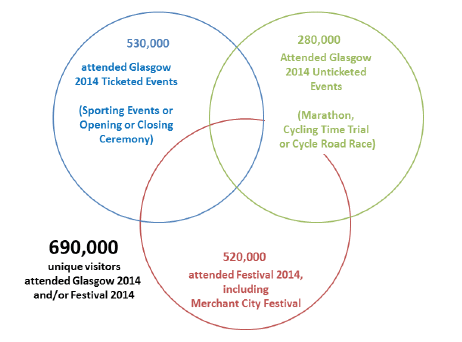
Note: Not to scale
2.5 Of the estimated 690,000 unique visitors attending Glasgow 2014 and/or Festival 2014 events between 23 July and 3 August:
- 530,000 (78% of all visitors) went to at least one of the Glasgow 2014 ticketed events (i.e. sporting events, and the Opening or Closing ceremonies).
- 280,000 (41% of all visitors) attended at least one of the Glasgow 2014 non-ticketed sporting events (i.e. triathlon, marathon, cycle time trial or cycle road race).
- 520,000 (75% of all visitors) attended Festival 2014, including the Merchant City Festival.
Origin of visitors and trip type
2.6 As shown in Figure 2.2, the vast majority (96%) of visitors lived in the UK:
- Just over two-thirds lived in Scotland, with similar proportions living in Glasgow (22% or 150,000 unique visitors), the rest of the Clyde Valley outwith Glasgow (23%/ 158,000) or elsewhere in Scotland (23%/ 160,000).
- Around a quarter lived in England (26%/ 180,000) while 2% were from Wales or Northern Ireland (20,000).
- The remaining 4% of visitors lived overseas (30,000) with over half of these visitors living in Commonwealth countries or territories, including UK dependencies and territories. Table A.1 in Annex A lists the countries of origin of these visitors in full.
Figure 2.2. Place of residence of visitors to Glasgow 2014 and Festival 2014
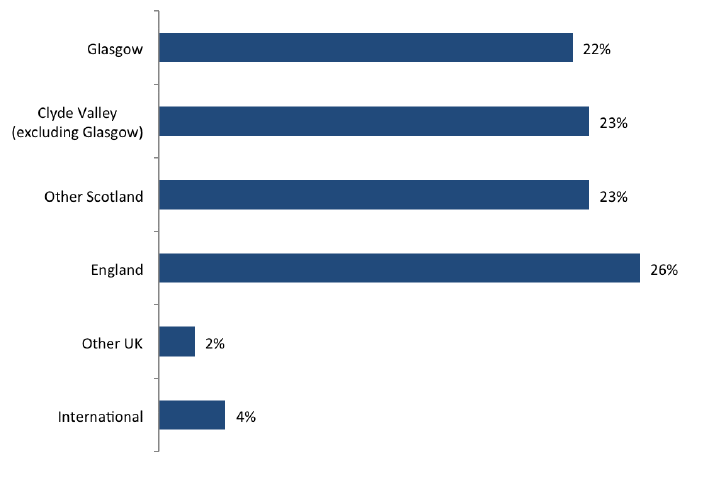
Base: All respondents (2,214)
2.7 Around two thirds of all visitors were on a day visit (63%/ 440,000) while the remaining 37% were overnight visitors (250,000), staying at least one night away from home as part of their visit.
2.8 As illustrated in Figure 2.3, the proportion of overnight visitors was highest amongst those who attended ticketed sporting events (44%) and lowest amongst those who attended non-ticketed sporting events and Festival 2014 events (32% and 33% respectively).
2.9 Correspondingly (as shown in Figure A.1 in Annex A) those who went to ticketed sporting events were more likely to have travelled from outside Scotland to attend while those attending non-ticketed sporting events and Festival 2014 events were more likely to be locals who lived in Glasgow.
Figure 2.3. Type of visit by events attended
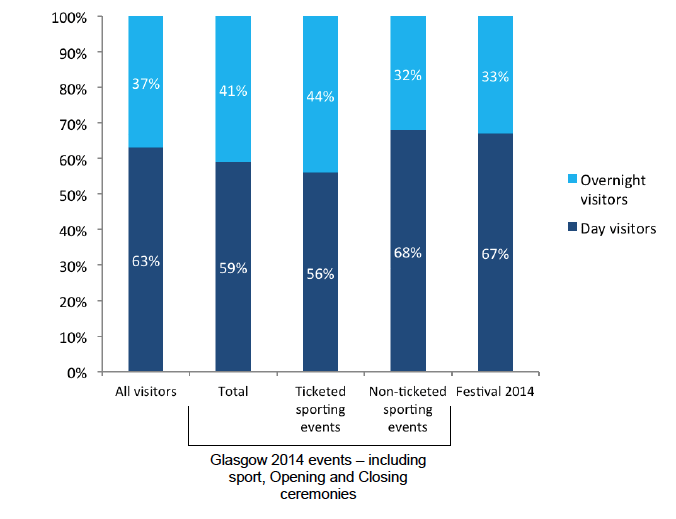
Base: All respondents (2,214)
2.10 Figure 2.4, compares the place of residence of day trippers and overnight visitors (also illustrated for UK residents in the map further below – see Figure 2.5). While most of those attending on a day trip lived in Glasgow or the remainder of the Clyde Valley, the majority of overnight visitors had travelled from England (67%) while 10% of this group were from overseas.
Figure 2.4. Place of residence of visitors by trip type
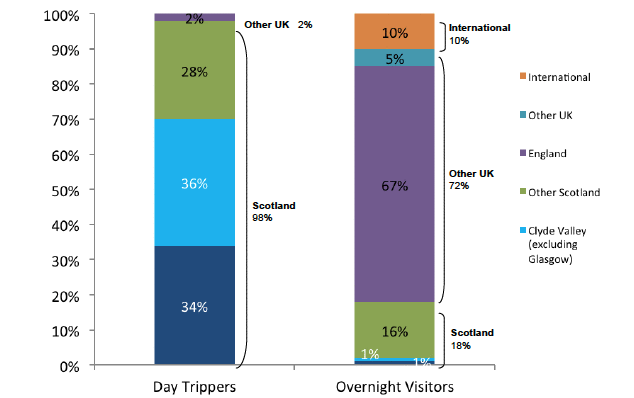
Base: All respondents (2,214)
2.11 As shown below (Figure 2.5) the largest proportions of visitors on an overnight trip lived in the North of England or London and the South East while the vast majority on a day trip lived in Glasgow or elsewhere in the Central Belt.
Figure 2.5. Place of residence if UK visitors by trip type
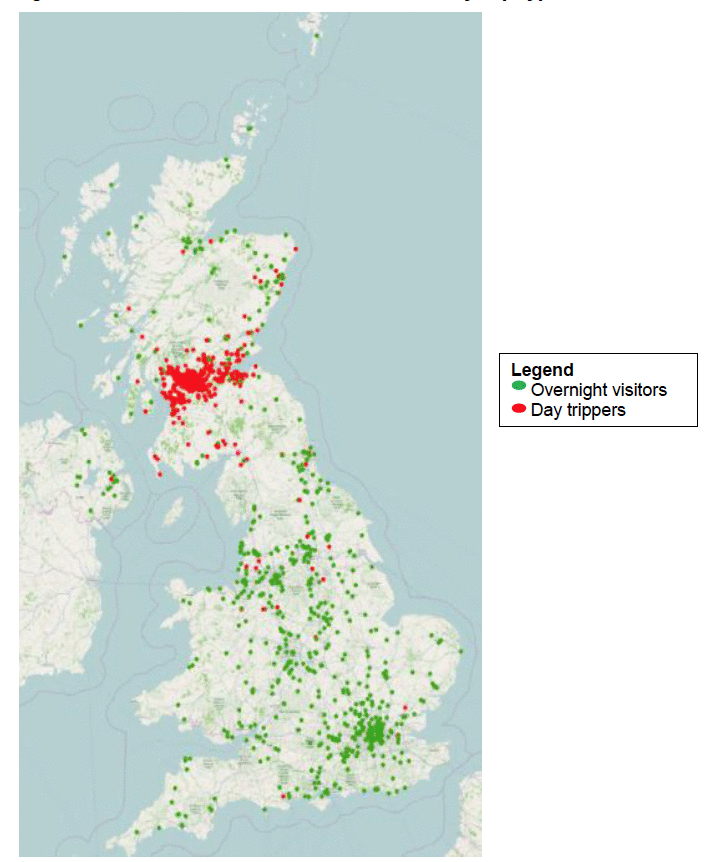
Base: All respondents (2,214)
Note: This map is intended to provide a useful visual representation of the distribution of the places of origin of visitors. However note that, given the high density of visitors from central Scotland, the 'dots' representing each visitor's home location overlap, masking the very high volumes of day visitors resident in this area.
Party composition
2.12 Around half of visitors attending Glasgow 2014 and Festival 2014 were with their spouse or partner (46%) while around a fifth attended with one of more children (20%) and a similar proportion attended with other members of their family or friends (20%).
2.13 The average party contained 2.6 people with children aged under 16 on average representing around 14% of visitors in the parties surveyed.
2.14 A slightly higher proportion of visitors resident in Scotland had children in their group (24%, reflecting the proportion of households with children in Scotland[9]).
2.15 Party composition was broadly similar across each of the different event types (see Table A.2 in Annex A for details).
Figure 2.6. Party composition – Glasgow 2014 and Festival 2014 visitors

Base: All respondents (2,214)
Note: Respondents could select more than one answer to reflect their party composition (e.g. if with friends and family members both answers would be selected). Therefore percentages sum to over 100%.
Demographic profile
Age
2.16 Figure 2.7 illustrates the age profile of adults attending the Games. This is based on the representative sample of the audience aged 16 and over who were interviewed (also note above regarding proportions of visitor parties also including children).
2.17 The largest proportion of adult visitors were in the 45 to 54 age group while the smallest proportions were in the youngest and oldest age groups. Comparing the age profile of adult visitors resident in the Scotland, with the Scottish population (Figure 2.7) illustrates the greater levels of attendance amongst those in the 35 to 64 age group while those aged 16 to 24 and 65 and over were less likely to attend.
Figure 2.7. Age profile of adult visitors
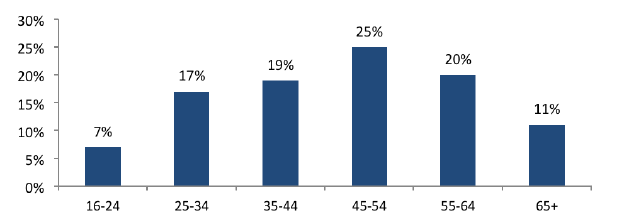
Base: All respondents (2,214)
Table 2.1. Age profile – Scottish adult visitors age profile compared to general population
| All visitors resident in Scotland | Scottish adult population* | |
|---|---|---|
| 16-24 | 8% | 14% |
| 25-34 | 18% | 16% |
| 35-44 | 20% | 16% |
| 45-54 | 24% | 18% |
| 55-64 | 19% | 15% |
| 65+ | 11% | 21% |
*ONS 2013 mid-year estimates
Base: All respondents who live in Scotland (1,411)
2.18 The age profile of visitors was broadly similar across each of the different event types (see Figure A.3 in Annex A).
Working status
2.19 As shown in Figure 2.8, most visitors attending the Games were in employment – either employed full time (55%), part time (11%) or self-employed (7%).
2.20 The working status profile of visitors was broadly similar across each of the different event types (see Figure A.4 in Annex A).
Figure 2.8. Working status profile
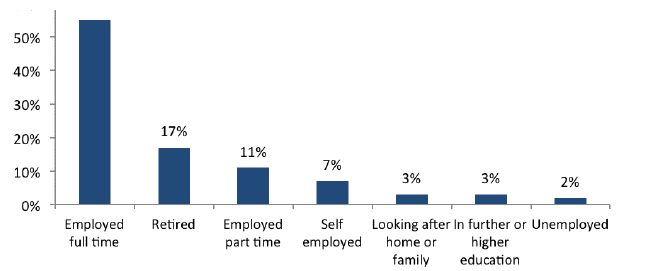
Base: All respondents (2,214)
2.21 Comparing the working status profile of visitors who lived in Scotland with the Scottish adult population (Table 2.2) illustrates the higher share of visitors who were employed full or part time while retired people were less likely to attend[10].
Table 2.2. Working profile – Scottish visitors compared to Scottish population
| All visitors resident in Scotland | Scottish adult population* | |
|---|---|---|
| Employed full-time | 53% | 37% |
| Retired | 16% | 24% |
| Employed part-time | 13% | 10% |
| Self-employed | 7% | 6% |
| Looking after the home or family | 4% | 7% |
| At school/ education/ training | 4% | 7% |
| Unemployed and seeking work | 2% | 5% |
*2013 Scottish Household Survey
Base: All respondents who live in Scotland (1,411)
Long term disabilities and conditions
2.22 Overall 4% of visitors stated that they had any of the following conditions or impairments, expected to last 12 months or more:
- Mobility/other physical impairment – 2% of visitors
- Visual impairment – 1% of visitors
- Hearing impairment – 1% of visitors
- Learning difficulty – less than 1% of visitors
- Something else – less than 1% of visitors
2.23 The proportion of visitors with any conditions or impairments was the same across attendees at all of the event types.
2.24 By comparison, the 2011 Census recorded that 20% of the Scottish adult population reported that their day to day activities were limited by a long-term health problem or disability[11].
Ethnicity
2.25 Overall 3% of visitors were members of a Black or Minority Ethnic population group (2% Asian, 1% mixed or multiple ethnic groups and less than 1% in all other groups).
2.26 This proportion varied by place of residence from 2% of those visitors living in Scotland and 2% of those living in in the rest of the UK (i.e. England, Wales or Northern Ireland) to 15% of those visiting from overseas.
2.27 By comparison, the 2011 Census recorded that 4% of the Scottish population were members of the Black and Minority Ethnic population.
Contact
Email: Duncan Whitehead
There is a problem
Thanks for your feedback